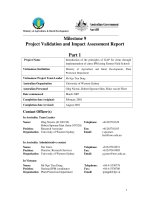Business statistic assignment 3 group report part 1 multiple regression
Bạn đang xem bản rút gọn của tài liệu. Xem và tải ngay bản đầy đủ của tài liệu tại đây (630.3 KB, 11 trang )
Business statistic- Assignment 3
Course nam
Course cod
Campus
Group
Team
Members
Lecturer
Table of Content:
Part 1: Multiple Regression :………………………………………………………………
1. Backward elimination (Appendix)…………………………………………
2. Final Model………………………………………………………………….
3. Team Regression Conclusion ……………………………………………
Part 2: Time Series: ……………………………………………………………………….
1. Time Series Trend Model (Appendix)…………………………………….
2. Time Series Trend Model recommendations…………………………….
3. Time Series Trend conclusion …………………………………………….
Part 3: Overall Team Conclusion :……………………………………………………..
Part 4: Reference List: ……………………………………………………………………….
Part 5: Appendix :………………………………………………………………………………
Part 1: Multiple Regression
1.2: Final Model
Independent Variable (IV)
Dependent Variable (DV)
Y: CO2 emissions (metric ton
per capita)
X1: The Gross National Income (GNI) per capita
in USD
X2: Renewable electricity output (% of the total
electricity output)
X3: Air transport, freight (million ton-km)
X4: Air transport, passengers carried
Data set I: All countries (ALL)
Regression output:
Multiple regression equation: Y
= 4.018+ 0.0001X -0.049X
1
2
Interpret the regression coefficient of the significant independent variables:
b = 0.0001: This means for each dollar of GNI per capita increase, Atlas method,
CO2 emissions will increase with 0.0001.
1
b = -0.049: This means for each percent increase in renewable electricity output,
CO2 emissions will decrease with -0.049.
2
Interpret the coefficient of
determination: R = 0.662 => 66.2 %
66.2% of the variation in GNI per capita and renewable electricity output can be
explained by the variation in CO2 emissions, and the remaining 33.8 % is due to
other factors which we do not take into consideration.
2
Data set II: Low-income Countries (LI):
Regression output:
In low-income countries dataset, there is no final model which is shown by the backward
elimination process included in the appendix. In conclusion, none of the independent variables
can be explained for the change in CO2 emissions in low-income countries.
Multiple regression equation:
There is no insignificant independent variable, we cannot build an equation for this
data set.
Data set III: Low-middle-income Countries (LMI):
Multiple regression equation: Y
= -0.317+ 0.001X
1
Interpret the regression coefficient of the significant independent variables:
b = 0.001: This means for each dollar increase in the GNI per capita, CO2
emissions will increase with 0.001.
1
Interpret the coefficient of
determination: R = 0.533 => 53.3 %
2
53.3% of the variation in GNI per capita can be explained by the variation in CO2
emissions, and the remaining 46,7% is caused by other factors that we do not take
into consideration.
DATA SET IV: UPPER-MIDDLE INCOME COUNTRIES:
Final regression equation:
Y = 5.468-0.050X2 + 0.0002X4
Interpretation of the regression coefficient of Renewable electricity
output and Air transport, freight:
b2 = -0.050 is the regression slope coefficient. This means for every percentage
renewable energy output, the level of CO2 released will decrease by 0.050.
b4 = 0.0002 is the regression slope coefficient. This means for every kilometer of
air transport freight, the level of CO2 released will increase by 0.0002.
Interpretation of the coefficient of determination:
As the coefficient of determination (R Square) = 44.3% (0.443), 44.3% of the variation
in level of CO2 released by a country is due to the variation of the renewable that
country can generate and the kilometer of air transport freight. Meanwhile, the
remaining 55.7% may be due to other factors which do not take into account.
DATA SET V: HIGH INCOME COUNTRIES:
Final regression equation:
Y = 12.475-0.097X2
Interpretation of the regression coefficient of Renewable electricity
output and Air transport, freight:
b2 = -0.097 is the regression slope coefficient. This means for every percentage
renewable energy output, the level of CO2 released will decrease by 0.097.
Interpretation of the coefficient of determination:
As the coefficient of determination (R Square) = 15.3% (0.153), it can be seen that
15.3% of the variation in level of CO2 released by a country is due to the variation of
the renewable that country can generate. Meanwhile, the remaining 84.7% may be
due to other factors which do not take into account.
1.3 TEAM REGRESSION CONCLUSION:
By analyzing the p-value of each variable in 5 datasets of 138 countries given above
with the same Significance level (α=0.05), it proved that three models of all
countries, upper-middle, and high-income countries have the same significant
independent variable that is renewable electricity output (% of total electricity output).
Besides, the regression of low-income countries does not have any significant
independent variable while the regression of all and upper-middle income countries
show one more significant independent variable as GNI and Air transport, freight,
respectively. As a consequence, the renewable electricity output shows a strong
influence on CO2 concentration rate.
It is vital to understand that renewable electricity becomes significant variable since it helps
cut on carbon emissions (United Nations 2018). This is due to the fact that electricity used to
generate from fossil fuel considering as the second largest factor emit
co2 concentration to the environment. In addition, based on the ideas of Planete
Energies (2016), coal has a carbon impact 20 times greater than renewables. Hence,
replacing fossil fuel in electricity production by other renewable energy sources will
reduce the flow of CO2 emissions to the atmosphere. Under those circumstances, it
can be concluded that renewable electricity output plays a decisive role in reducing
electricity’s environmental footprint.
It has been shown that upper-middle income group has the highest coefficient of determination
(R squared = 44.3%) compared to all, lower-middle income, high income ratios as 43.8%,
28.4%, and 15.3%, respectively. It means the regression models of upper-middle income
countries would describe the best estimation among 5 given data sets. Speaking about this, R
squared is a statistic that usually ‘interpreted as summarizing the percent of variation in the
response that the regression model explains’ (Ford, C 2015). That is to say, R squared = 0.443
means 44.3% of the model’s alternation will be explained in our dependent variable, in this
case is CO2 emissions.
Part 2: Time Series
2.2: Time Series Trend Model recommendations:
The calculation of the errors, MAD, SSE and Trend Model Recommendation
In order to make the best prediction for CO2 emissions, it is necessary to scrutinize
which trend model is the most suitable for each country by identifying the smallest in
both MAD and SSE. Based on the calculation and the comparison, these figures are
highlighted in the table above to be equivalent to the trend model recommendation for
each country.
2.3 Time Series Trend conclusion:
The line chart above indicates the CO2 emissions amount in four countries inclusive of
Sierra Leone, Jordan, Maldives, and Argentina over 28 years, from 1986 to 2014.
Overall, it is seen that the same trend in CO2 emissions has not occurred among the
given countries. In more specific, Jordan and Argentina accounted for the highest
amount of CO2 emissions at the beginning of the observed period (1986) with
approximately 3.5 metric tons per capita, in contrast, two residual countries Sierra
Leone and Maldives had the lowest CO2 emissions with 0.2 and 0.4 metric tons per
capita, respectively. Until the end of this period, the CO2 emissions in Maldives and
Argentina tended to increase significantly, a slightly decreasing trend was witnessed in
Jordan and the trend for Sierra Leone seemed to be unchanged. It is worth notice that
the CO2 emissions in the Maldives in 2014 gone up beyond the first level which
equals CO2 emissions in Jordan at the same time. By identifying the trend models of
all countries; Sierra Leone, Maldives, and Argentina are three nations following the
linear trend model, while there is just Jordan pursuing the Quadratic trend model. To
sum up, based on the time series analysis, the majority of the smallest figures of MAD
and SSE fall into the Linear trend model, additionally, it is followed by most numbers of
countries (3 out of 4). Therefore, the Linear trend model is considered to be the best
predictor for CO2 emissions.
Part 3: Overall Team Conclusion
In term of our analysis, our team have 95% confidence that there is a significant
relationship between CO2 emissions and Gross Nation Income (GNI per capita).
According to the it is proved that the developed
countries has higher CO2 emissions rather than developing countries, which
indicated the strong relationship between CO2 emissions and GNI per capita.
Based on the multi regressions we have already consolidated that CO2 emissions are
strongly influenced by different significant independent variables at different level
income of the countries, the evidence of which can be seen in high-income countries,
upper-middle income countries, low-middle income countries and low income
countries. To be more specific, the main factors that affect CO2 emissions is
renewable electricity output in high-income countries. As for upper-middle-income
countries, 44.3% of variation in CO2 emissions can be explained by variation in
renewable electricity output and air transport, freight. In low-income countries, the
variables in the dataset are non-significant so that CO2 emissions may caused by
other factors that we do not take into consideration.
In 2030, the CO2 emission around the world will increase significantly. We are 95%
confident that the CO2 emissions all around the world in the future will go up based
on the hypothesis test on the Assignment 2. In Assignment 3, Linear trend model is
the most reliable method to predict CO2 emissions. Hence, we can forecast the CO2
emissions in 2039 of Argentina will be …. , which increase compared to the prediction
in 2014 (4.56 metric ton per capita).
… (2019) have stated that the main factors that driving for CO2 emissions in the
future is income, moreover, CO2 emissions in global in the future is significant
/>
According to United Nation ( 2018) , the global warming are increasing alarmingly, the
total annual greenhouse emissions including from land use change reach the highest
(53.5 gigaton) in 2017; they stated that the CO2 emissions in 2030 will be reduced
since there are some policy that government will implement.
/>
Moreover, UN Environment proved that Forest fires, dust storms, volcanic eruptions,
pollen dispersal, sea spray, evaporation of organic compounds and natural radioactivity
are some of the driving factors that lead to global warming and CO2 emissions
increase; some countries has enacted their own law to address land expansion and fire
forest.
/>
sequence=1&isAllowed=y. Changing government policy which are our
recommendations such as increasing the tax for the fossil fuel energy and having more
control in the land in the forest. Consequently, we would suggest those factors for
further research as they may have a significant influence on CO2 emissions, so that we
can have a more accurate and reliable result.
Part 4: Reference List:
Part 5: Appendix









